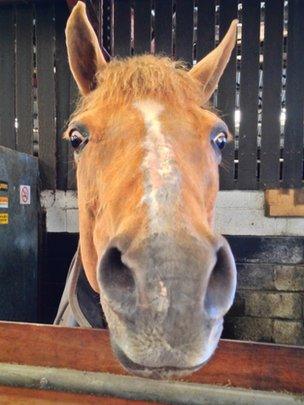Horses' mobile ears are 'communication tool'
- Published

Very mobile ears help many animals direct their attention to the rustle of a possible predator.
But a study in horses suggests they also pay close attention to the direction another's ears are pointing in order to work out what they are thinking.
Researchers from the University of Sussex say these swivelling ears have become a useful communication tool.
Their findings are published in the journal Current Biology.
The research team studies animal behaviour to build up a picture of how communication and social skills evolved.
"We're interested in how [they] communicate," said lead researcher Jennifer Wathan.
"And being sensitive to what another individual is thinking is a fundamental skill from which other [more complex] skills develop."
Ms Wathan and her colleague Prof Karen McComb set up a behavioural experiment where 72 individual horses had to use visual cues from another horse in order to choose where to feed.
They led each horse to a point where it had to select one of two buckets. On a wall behind this decision-making spot was a life-sized photograph of a horse's head facing either to left or right.
In some of the trials, the horses ears or eyes were covered.
If the ears and eyes of the horse in the picture were visible, the horses being tested would choose the bucket towards which its gaze - and its ears - were directed.
If the horse in the picture had either its eyes or its ears covered, the horse being tested would just choose a feed bucket at random.
Like many mammals that are hunted by predators, horses can rotate their ears through almost 180 degrees - but Ms Wathan said that in our "human-centric" view of the world, we had overlooked the importance of these very mobile ears in animal communication.
Lead researcher Jennifer Wathan explains how the team tested each horse's decision-making
"It seems there's something in the visual cues - from both the eyes and the ears - that are really important," she told BBC News.
"Horses have quite rich social lives and relationships with other horses, so they're a good species to look at this in.
"And the more we look at communication across different species, the more we can consider what might have promoted the evolution of sophisticated communication and social skills."
- Published13 July 2014
- Published4 July 2014
- Published30 March 2011